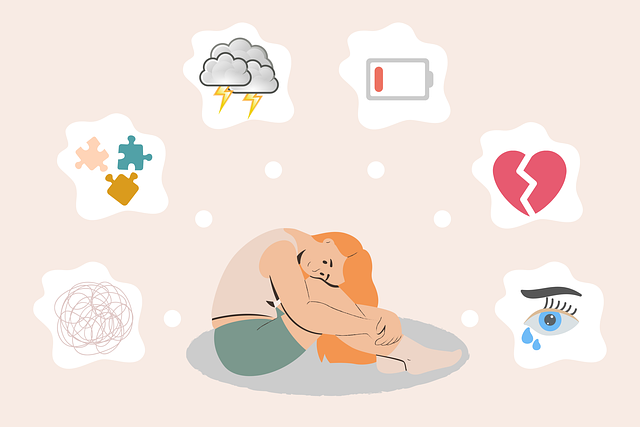Understanding mental illness representation in media, especially bipolar disorder, is crucial for combating stigma and promoting empathy. Accurate depictions, like those featuring authentic therapy experiences (e.g., Parker Bipolar Disorder Therapy), can enhance public understanding and encourage early intervention. Stereotypes and simplistic portrayals contribute to misconceptions, affecting help-seeking behaviors and community reception. Therefore, advocates must engage with media outlets, collaborate with professionals and individuals living with bipolar disorder, and design educational programs to challenge myths and promote diverse, empathetic narratives, ultimately reducing stigma and improving mental health outcomes.
In today’s media landscape, accurate representation of mental illness is crucial. This article delves into the challenge of depicting bipolar disorder, a complex condition often stigmatized, and explores solutions through case studies like Parker’s journey with therapy. We examine the impact of media portrayal on individuals’ self-perception and mental health, offering strategies for promoting empathetic depictions. Furthermore, we highlight the vital role of mental health professionals in collaborating with media to foster understanding and reduce stigma, particularly in stories about bipolar disorder therapy.
- Understanding Mental Illness Representation in Media
- The Impact of Stigmatization on Individuals with Bipolar Disorder
- Parker's Story: A Case Study on Effective Media Portrayal
- Strategies for Promoting Accurate and Empathetic Depictions
- The Role of Mental Health Professionals in Media Collaboration
Understanding Mental Illness Representation in Media

Understanding Mental Illness Representation in Media involves recognizing how various forms of media, from television shows to films and news outlets, portray individuals living with conditions such as bipolar disorder. It’s crucial to distinguish between accurate, empathetic representations that promote awareness and understanding, and stereotypes or simplistic portrayals that reinforce stigma. For instance, featuring characters undergoing Parker Bipolar Disorder Therapy can showcase the complexities of managing mental health while emphasizing the importance of professional support.
Media has a significant impact on shaping public perceptions, making accurate representation vital for fostering compassion cultivation practices and stress reduction methods within society. Inadequate or misleading portrayals can contribute to misconceptions about mental illness, impacting how individuals affected seek help or are received by their communities. Therefore, advocates for Mental Health Policy Analysis and Advocacy must engage with media outlets to promote authentic narratives that reflect the lived experiences of those dealing with these challenges.
The Impact of Stigmatization on Individuals with Bipolar Disorder

Stigmatization surrounding mental health conditions, such as bipolar disorder, can have profound effects on individuals living with this illness. The impact is multifaceted, affecting self-esteem, social interactions, and access to support systems. Many people struggle in silence due to the fear of judgment and discrimination, which can lead to isolation and a delay in seeking much-needed treatment. This internalized stigma may cause individuals to doubt their experiences and even discourage them from pursuing Parker Bipolar Disorder Therapy or other forms of specialized care.
In today’s world, where media representation plays a significant role in shaping public perception, it is crucial to challenge these negative stereotypes. Mental Health Education Programs Design can empower both mental health professionals and the general public by fostering empathy and raising awareness. By implementing Risk Management Planning for Mental Health Professionals, we can create safer spaces for open dialogue, encouraging early intervention and better support for those with bipolar disorder. Empathy Building Strategies should be at the core of these efforts to break down barriers and promote understanding, ultimately leading to improved mental health outcomes.
Parker's Story: A Case Study on Effective Media Portrayal

Parker’s story, a young adult grappling with bipolar disorder, offers a compelling case study on how media can effectively portray mental illness and its journey to recovery. The narrative, featuring Parker’s struggles, therapy sessions, and eventual triumph over their condition, serves as a powerful tool for raising awareness and challenging stereotypes. Through this representation, viewers gain insights into the complexities of bipolar disorder, fostering empathy and understanding.
The case study highlights key aspects such as the importance of accurate diagnosis, effective communication strategies between Parker and their healthcare provider, and the role of cultural competency training in ensuring that support is tailored to Parker’s unique needs. By showcasing these elements, it encourages mental health advocates, healthcare providers, and the general public to adopt better stress reduction methods and improve overall communication strategies in discussions around mental illness.
Strategies for Promoting Accurate and Empathetic Depictions

Promoting accurate and empathetic depictions of mental illness in media involves several key strategies. One crucial approach is to consult with experts, including psychologists, therapists like Parker Bipolar Disorder Therapy professionals, and individuals living with various conditions. Their insights can ensure stories are not only authentic but also sensitive to real-life experiences. Encouraging diverse representations is equally vital; showing a range of mental health struggles and recovery journeys helps challenge stereotypes and increases understanding among the public.
Public awareness campaigns development should focus on humanizing these issues. Portraying characters with depth and complexity, rather than relying on cliches, can go a long way in boosting confidence and reducing stigma. Integrating Mental Health Awareness themes into popular narratives allows for open conversations about mental illness, fostering an environment where support and understanding are more accessible.
The Role of Mental Health Professionals in Media Collaboration

Mental health professionals play a pivotal role in ensuring accurate and empathetic representation of mental illness in media. By collaborating with writers, directors, and producers, they can offer insights into the lived experiences of individuals grappling with conditions like bipolar disorder (as exemplified by Parker Bipolar Disorder Therapy). This collaboration is crucial for creating nuanced narratives that challenge stereotypes and promote understanding.
Incorporating cultural sensitivity in mental healthcare practice is essential to this process. Professionals can guide media creators on how to represent diverse populations accurately, especially when depicting specific mental health issues. Moreover, encouraging the integration of mindfulness meditation techniques—a practice shown to aid in burnout prevention—in scripts or visual storytelling can add depth and promote positive mental health messages.
Media representation of mental illness plays a pivotal role in shaping public perception. By learning from cases like Parker’s bipolar disorder therapy, where accurate and empathetic portrayals can make a significant difference, we can foster a more understanding society. Integrating strategies for promoting positive media depictions and encouraging collaboration between mental health professionals and media creators is crucial to challenging stigmatization. Through these efforts, we can work towards a future where individuals with mental health conditions feel seen, heard, and supported.









